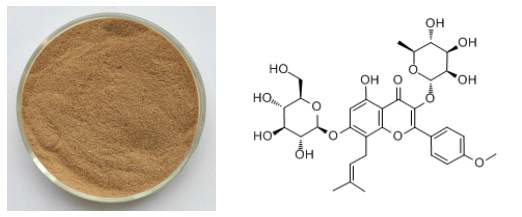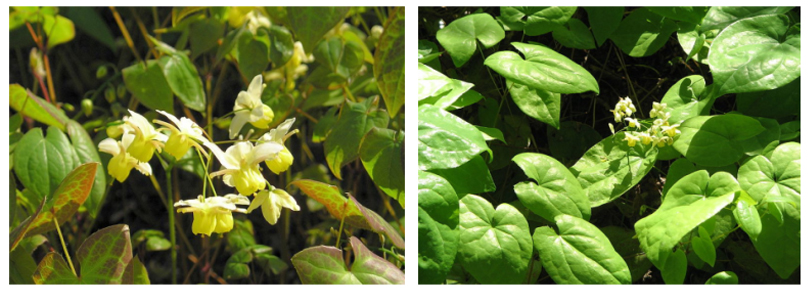Bottom price for Epimedium Extract Factory in Juventus
Bottom price for Epimedium Extract Factory in Juventus Detail:
[Latin Name] Epimedium sagittatnm Maxim
[Plant Source] Leaf
[Specification] Icariin 10% 20% 40% 50%
[Appearance] Light yellow fine powder
Plant Part Used: Leaf
[Particle size]80Mesh
[Loss on drying] ≤5.0%
[Heavy Metal] ≤10PPM
[Pesticide residue] EC396-2005, USP 34, EP 8.0, FDA
[Storage] Store in cool & dry area, keep away from the direct light and heat.
[Shelf life] 24 Months
[Package] Packed in paper-drums and two plastic-bags inside.
[Net weight] 25kgs/drum
[What is Epimedium?]
Epimedium extract is a popular aphrodisiac supplement and herbal sexual performance enhancer.It has a long history of traditional use in China for the alleviation of erectile dysfunction and for improving libido and fertility.
Also known as Horny Goat Weed, this supplement supposedly got its name after a farmer noticed that his flock of goats were particularly aroused after eating flowers of a specific type. These Epimedium flowers contain icariin, which is a natural compound that increases blood flow to sexual organs and promotes sex drive. Icariin has been found to increase Nitric Oxide synthesis as well as inhibiting the activity of the PDE-5 enzyme
[Icariin in Epimedium Extract]
Epimedium extracts powder contain an active phytochemical called icariin.Icariin has been observed to exhibit a number of useful traits, including renoprotective (liver protecting) hepatoprotective (kidney protecting), cardioprotective (heart protecting) and neuroprotective (brain protecting) effects.
It is also an antioxidant and can cause vasodilation. It exhibits antimicrobial characteristics and is thought to act as an aphrodisiac.
Icariin is classified as a flavonol glycoside, which is a type of flavonoid. Specifically, icariin is the 8-prenyl derivation of kaempferol 3,7-O-diglucoside, a prevalent and important flavonoid.
[Function]
1. Combat mental and physical fatigue;
2. Induce vasodilation and improve circulation;
3. Lower blood pressure in hypertensive patients;
4. Improve symptoms of erectile dysfunction (ED) through its action as a PDE5 inhibitor;
5. Improve the use of free testosterone in the blood;
6. Increase libido;
7. Alleviate symptoms of depression and stimulate improved cognitive function;
8. Protect against neurological degeneration.
Product detail pictures:

Related Product Guide:
owing to fantastic assistance, a variety of high quality goods, aggressive rates and efficient delivery, we love a very good popularity among our customers. We are an energetic firm with wide market for Bottom price for Epimedium Extract Factory in Juventus , The product will supply to all over the world, such as: Iran, Malta, Rotterdam, By integrating manufacturing with foreign trade sectors, we can provide total customer solutions by guaranteeing the delivery of right products to the right place at the right time, which is supported by our abundant experiences, powerful production capability, consistent quality, diversified product portfolios and the control of the industry trend as well as our mature before and after sales services. We'd like to share our ideas with you and welcome your comments and questions.
Top quality products: https://bit.ly/HealthBuyStore I Found my favorite health & sex supplements and natural beauty products right here.
how to enhance male sexual performance – male enhancement ways
Go on watching: https://www.niche-finder.net/getpebible
A safe penis enlargement method never includes the penile pump devices, chemical drugs or unhealthy surgeries. Like a big number of males who get a bigger penis size naturally, you may also get the right one among those natural male enhancement ways to safely enlarge your penis.
If you are interested in how to enhance male sexual performance especially your penis, you may get certain valuable advices from this self help program.
This training explains how your penis works, what boosts your penile growth and proves a man could expect extra 2~4 inches of growth through the combination of scientific biological enhancement and penis exercises.
You are just required to take several minutes every day to follow its simple steps, but the result is permanent. After completing its 8-week training carefully, you will not only add inches to your penis girth and length, but also enhance overall your sexual performance; you will be able to gain more stamina in bed to have sexual intercourse with your partner.
Products and services are very good, our leader is very satisfied with this procurement, it is better than we expected,






